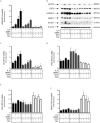Iron overload inhibits BMP/SMAD and IL-6/STAT3 signaling to hepcidin in cultured hepatocytes
- PMID: 34161397
- PMCID: PMC8221488
- DOI: 10.1371/journal.pone.0253475
Iron overload inhibits BMP/SMAD and IL-6/STAT3 signaling to hepcidin in cultured hepatocytes
Abstract
Hepcidin is a peptide hormone that targets the iron exporter ferroportin, thereby limiting iron entry into the bloodstream. It is generated in hepatocytes mainly in response to increased body iron stores or inflammatory cues. Iron stimulates expression of bone morphogenetic protein 6 (BMP6) from liver sinusoidal endothelial cells, which in turn binds to BMP receptors on hepatocytes and induces the SMAD signaling cascade for transcriptional activation of the hepcidin-encoding HAMP mRNA. SMAD signaling is also essential for inflammatory HAMP mRNA induction by the IL-6/STAT3 pathway. Herein, we utilized human Huh7 hepatoma cells and primary murine hepatocytes to assess the effects of iron perturbations on signaling to hepcidin. Iron chelation appeared to slightly impair signaling to hepcidin. Subsequent iron supplementation not only failed to reverse these effects, but drastically reduced basal HAMP mRNA and inhibited HAMP mRNA induction by BMP6 and/or IL-6. Thus, treatment of cells with excess iron inhibited basal and BMP6-mediated SMAD5 phosphorylation and induction of HAMP, ID1 and SMAD7 mRNAs in a dose-dependent manner. Iron also inhibited IL-6-mediated STAT3 phosphorylation and induction of HAMP and SOCS3 mRNAs. These responses were accompanied by induction of GCLC and HMOX1 mRNAs, known markers of oxidative stress. We conclude that hepatocellular iron overload suppresses hepcidin by inhibiting the SMAD and STAT3 signaling pathways downstream of their respective ligands.
Conflict of interest statement
The authors have declared that no competing interests exist.
Figures




References
Publication types
MeSH terms
Substances
Grants and funding
LinkOut - more resources
Full Text Sources
Miscellaneous

